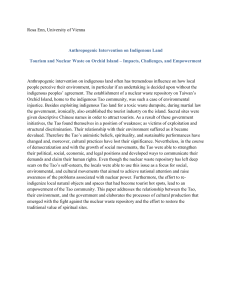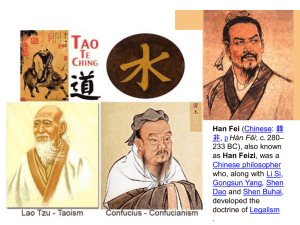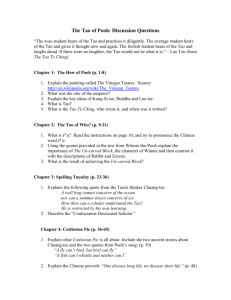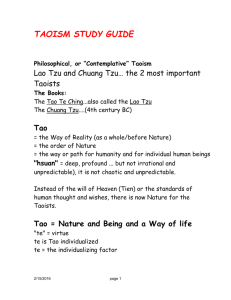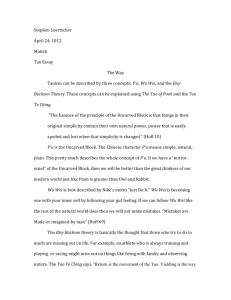CDI Introduction to Innovative Design Thinking
advertisement
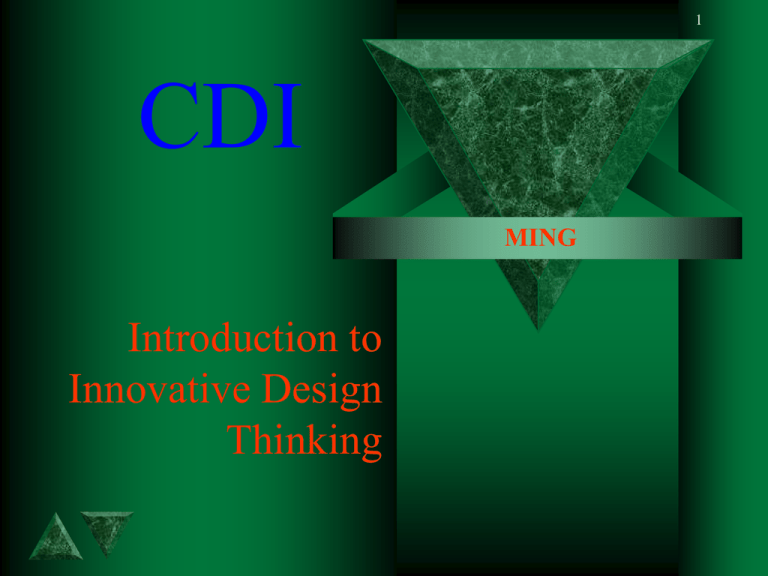
1 CDI MING Introduction to Innovative Design Thinking Lecture 7 1. 2. 3. 4. 5. Tao’s Thinking The use of nothingness Application of Tao in Education To Design a project Cultural barriers 2 Tao’s thinking in Education 1. What is Tao (道)? 2. What is Nothingless“Wu”(無)? 3. Application of Tao in Education 3 Tao’s thinking in Education 文字 創意 圖象 美學 文化 老莊 4 Tao’s thinking in Education 學會學習 5 Tao’s thinking in Education Perception Concept Idea WHY WHAT HOW 6 Tao’s thinking in Education Concept formation Knowledge Concept Experience 7 Tao’s thinking in Education Knowledge formation Personal Codified Tacit Knowledge Knowledge Knowledge 8 Tao’s thinking in Education New Perception Perception Concept Idea Heritage 9 Tao’s thinking in Education New Perception Perception Proficiency of Languages Concept Idea Heritage 10 Tao’s thinking in Education Lo-gy (老子) has many off springs: Archaeo-logy Geo-logy Numero-logy Ultra-logy Bio-logy Horo-logy Onto-logy Zymo-logy Crimino-logy Ideo-logy Psycho-logy Archeo-logy Dermato-logy Limno-logy Socio-logy Methodo-logy Eco-logy Metro-logy Techno-logy Termino-logy ……………………………………… 11 Tao’s thinking in Education 道=無 12 Tao’s thinking in Education 無 道=無 有 13 Tao’s thinking in Education 道生一 , 一生二 , 二生三 , 三生萬物 14 Tao’s thinking in Education 文字 老莊 創意 文化 圖象 美學 15 Tao’s thinking in Education 文字 老莊 創意 文化 圖象 美學 16 Tao’s thinking in Education 合一 17 Tao’s thinking in Art & Design Education 合一 無 18 Tao’s thinking in Art & Design Education 有 無 19 Tao’s thinking in Art & Design Education 有 無 無 20 Tao’s thinking in Education 吾生也有涯 , 而知亦無涯 , 以有涯隨無涯 , 殆而已矣 . 21 Tao’s thinking in Education 學會學習 22 Tao’s thinking in Education 知其不知 不知所知 23 Tao’s thinking in Education 有=有 24 Tao’s thinking in Education 25 Tao’s thinking in Education 無=有 26 Tao’s thinking in Education 27 Tao’s thinking in Education 無中生有 28 Tao’s thinking in Education 29 Tao’s thinking in Education 文字=無名 創意=無知 圖象=無物 美學=無心 文化=無識 老莊=無 30 Tao’s thinking in Education 有意栽花花不發 無心插柳柳成蔭 31 Use of Nothingness You know everything, you are nothing! You know nothing, you are everything! 32 Use of Nothingness Imagine: A white board is useful when it is empty. Once it was filled with scribbling, it is useless. 33 Use of Nothingness One can eat because one is hungry. One can learn because one is empty! 34 Use of Nothingness One can be creative because one knows nothing about what s/he is doing. And once you don’t know, there you have room to grow. 35 Use of Nothingness To be creative….. = To be empty! 36 Use of Nothingness As an educator, we are trained to “feed” students and make them full. 37 Use of Nothingness As a creative educator, we are trying to “feed” them with knowledge and then empty them out. 38 Use of Nothingness To empty your students, empty yourself first. The greatest enemy in creativity is always you – yourself!!!! 39 Use of Nothingness Enjoy knowing nothing, then you will know everything out of nothing; and then empty out and being nothingness again. 40 References 吳汝鈞, 老莊哲學的現代 析論, 文津出版 1998 41 Design a project To design a design project, there are some points we teachers need to pay attention into. 42 Design a project We have to find a theme suitable for students. How can we find this? Ask the student. Treat yourself as a student. 43 Design a project We have to find the NEED suitable for design activity. But, what is the Need? 44 Design a project The NEED can be at different levels: To student To teacher To school 45 Design a project To parents To Education Department To society To China To mankind 46 Design a project To me, the NEED is to stimulate students independent and innovative thinking, to develop confident and to self-transcend. 47 Design a project There is a well known problem in Design education issued by ED????(Not sure) The ill-defined design problem. 48 Design a project To me, there is NO ill-defined design problem, there is only ill-conceptual and “lazy” thinker. 49 Design a project A design project should be full of fun, challenges, interesting and worth learning. If most of the students do not like the project, it is a poor project. Fun is the key in Creativity. 50 Design a project The theme should be closely related to students’ knowledge, experience and / or familiar environment. It may be useful sometimes for students to decide their themes. 51 Design a project The theme should have room for interpretation. If the design project falls into the subordinate area, teacher must help students to find the way out. 52 Design a project The project brief should clearly describe the situation of the problem, the criteria, resources available, content / context to be covered, submission and DEADLINE. 53 Design a project Plan carefully the content you are going to conduct within the lessons, and examine the feasible possibilities. If you know the outcome already, it is not a good project. 54 Design a project Encourage students to challenge the theme, to interpret it, to analyze it, question it and even propose anti-theme for the project. 55 Design a project Personal tutorial is very useful for teacher to read students’ mind. This can arouse their creativity because you teacher feels interesting and do care about how they think. 56 Design a project Encourage students to make full use of their knowledge not only within the design domain but everything they know for the project. 57 Design a project Exhibit or record down students’ works and show your appreciation for their affords. Give full marks if they deserved, and write comments on their works. 58 Design a project Teaching students to be creativity means killing teachers’ time and patient. The more you contribute, the more you yourself to be proud of. You can master creativity! 59 Culture What is Culture? Culture is what’s shared by a large group and transmitted across generations – ideas, languages, beliefs, attitudes, behaviors and traditions. 60 Culture It is also a collective value system for a nation to think, analyze, criticize and agree with specific issues. Culture is a living social organism, which transcend through time. 61 Culture Different types of Culture: 1. High Culture 2. Popular Culture 3. Sub Culture 62 Culture We have to know the cultural background of our situation and the participants under any creative works. Why? 63 Culture So that you know their history, need, their value judgments, beliefs, and most important, you know how they think and interpret. 64 Culture Citizens within a specific culture can communicate effectively not only because they speak the same languages, but also think and interpret things in similar attitudes under the same value system. 65 Culture Under the same culture, citizens will understand the specific signs and symbols using in their premises, which are really difficult for the outsider to decipher. 66 Culture The signs and symbols must echo to the consumers’ daily lives in order to activate the consumption desire. However, most consuming intention is unconscious and super-ego. 67 Culture Signification can only happened under the umbrella of the same culture, and the signifier becomes the idealist practice of one’s wish. 68 Culture Nowadays, consumption is cohere with culture. Despite the fact that Globalism becomes one of the horrible threat of Nationalism, creativity still stick to the end users. 69 Culture Knowing you (students; parents and significant others) and knowing me (teacher) is a Chinese slang, which is true whenever you wanted to initiate any new and creative move within educational domain. 70 References Consumption, Robert Bocock, 1993 Social Psychology, David G. Myers, 1999, 6th Edition 71 72 Ming Thank You

